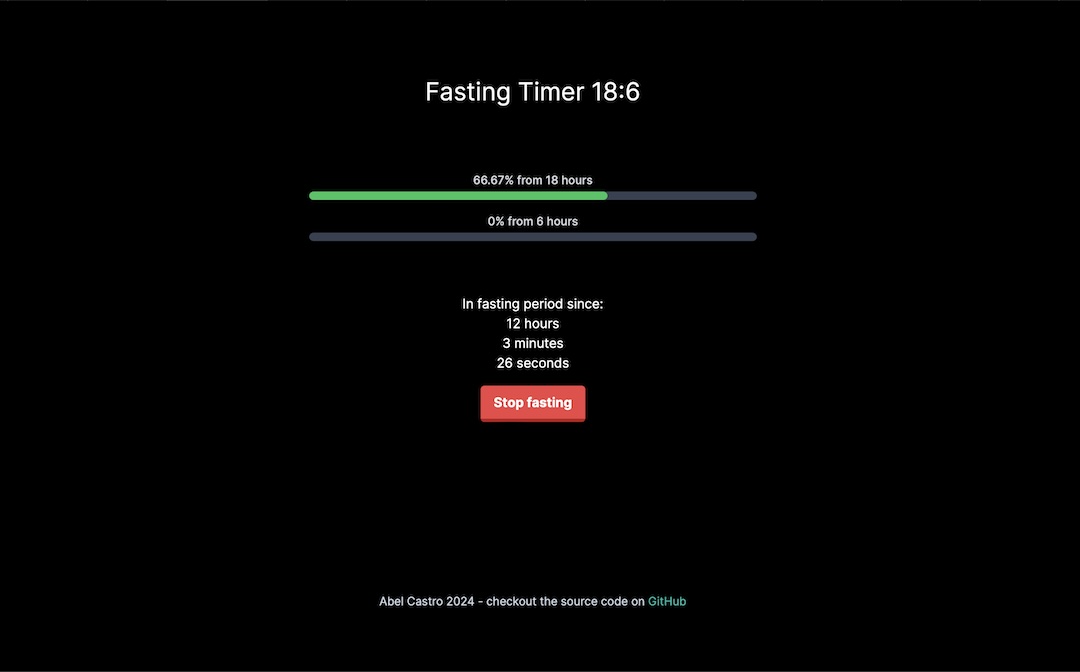Building Fasting Timer 18:6: A Learning Journey with React, Next.js, and More
2024-07-26
2024-07-26

In my journey of learning more about React and Next.js, I created a new project: Fasting Timer 18:6. In this blog post, I'll take you through the details of the project, the key learnings, and some interesting technical aspects that might be helpful for fellow developers.
You can check out the project repository here and try the live app here.
Fasting Timer 18:6 is a simple yet effective application designed to help users manage their intermittent fasting schedules. The 18:6 fasting method involves fasting for 18 hours and eating during a 6-hour window. This app helps users keep track of their fasting and eating times with ease.
Working on this project provided me with several valuable learning opportunities:
import { render, screen, fireEvent, act } from "@testing-library/react";
import Home from "../app/page";
import storageService from "../app/storage/storage-service";
it("should start the timer and switch to fasting/eating mode after clicking the button", async () => {
const { container } = render(<Home />);
expect(container).toMatchSnapshot();
// Start fasting
const button = screen.getByRole("button", { name: /Start fasting/i });
await act(async () => {
fireEvent.click(button);
});
expect(container).toMatchSnapshot();
const startFastingTime = storageService.getStartFastingTime();
expect(startFastingTime).toBeInstanceOf(Promise<Date>);
// ...
});
One of the interesting aspects of the project is the StorageService. This service is designed to manage the storage and handling of fasting and non-fasting times.
Key Points:
BrowserStorage, which stores data in the user's local browser storage.IStorageProvider interface is defined. This interface outlines the necessary methods that any storage provider must implement.IStorageProvider interface and update the storage service configuration.Example Implementation:
const storageService = new StorageService(new BrowserStorageProvider());
export default storageService;
With this design, changing the persistence layer is as simple as touching two files—implementing the new storage provider and updating the configuration.
Working on the Fasting Timer 18:6 project has been an enriching experience. From learning to write tests with Jest to creating a flexible storage solution, each step has contributed to my growth as a developer. I hope this blog post provides valuable insights and encourages you to explore and implement these concepts in your projects.
Feel free to check out the repository, try the app, and provide any feedback or contributions. Happy coding!
Try the live app here.
The primary goal of my blog has always been to experiment and explore new technologies rather than getting more views. This journey has seen my blog evolve through various technologies and frameworks, each iteration bringing its own set of learnings and advancements. Here’s a look back at the history and the latest re-implementation of my blog.
The initial version of my blog was launched in 2021. At that time, I chose Django as the primary framework for its robustness and extensive feature set. Django templates allowed for server-side rendering, while Bootstrap provided a responsive and modern look to the blog. This combination was powerful and relatively easy to work with, making it a perfect choice for someone looking to build a solid foundation.
As time went on, I began exploring more dynamic ways to enhance the user experience. This led to the incorporation of htmx, which allowed for more interactive web pages without the need for full page reloads. Additionally, I implemented a REST API, which opened up possibilities for future integrations and provided a more modular approach to data handling. This version of the blog, which has seen significant evolution, is still live and can be found at https://abelcastro.dev/blog.
In parallel, I also experimented with Angular, a powerful framework for building dynamic web applications. This version, although not always functional, was hosted separately at https://ng.abelcastro.dev. This experiment allowed me to understand the intricacies of a component-based architecture and single-page applications, providing valuable insights into modern web development practices.
The latest iteration of my blog is available at https://blog.abelcastro.dev. This will be the default version of my blog on which I will focus in the future. It represents a significant leap forward in terms of technology and developer experience. Developed with Next.js and styled with Tailwind CSS, this version is sleek, fast, and highly responsive. Next.js offers a perfect balance between server-side rendering and static site generation, ensuring optimal performance and SEO benefits. Tailwind CSS, with its utility-first approach, makes it easy to create a custom and consistent design system.
Hosting this new version on Vercel’s platform as a hobby project has been a delightful experience. After being used to handling server configurations and Docker files, it was amazing to simply link my GitHub repository with Vercel and have the code deployed seamlessly.
One of the exciting aspects of this re-implementation was the opportunity to apply techniques I learned from the Next.js dashboard tutorial. Features like pagination and search have been integrated, enhancing the functionality and usability of the blog. These features not only improve the user experience but also showcase the powerful capabilities of Next.js and the ease with which complex features can be implemented.
The evolution of the code and posts on my blog reflects part of my journey as a developer. I am very happy with the results and excited to learn more about TypeScript and frameworks like Next.js.
By the way, all these projects are available in my github profile.
I recently followed the Next.js Dashboard tutorial (https://nextjs.org/learn/dashboard-app) and made a few modifications to run the database locally using Docker instead of Vercel's DB hosting. You can check out my repository here: https://github.com/abel-castro/nextjs-dashboard
I hope this can be useful for someone!
Happy coding!